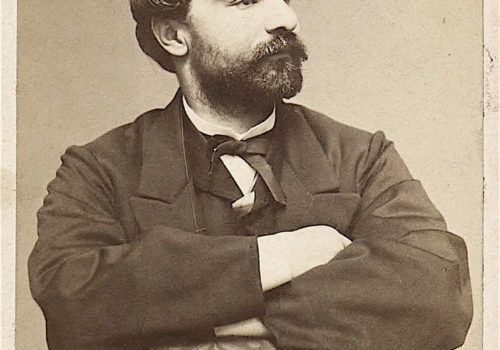Born on April 1, 1828, Étienne Carjat was younger than both Nadar and Baudelaire by about eight years.
Political ideas were never far from his mind throughout his life; he was a politically active man who, at the age of twenty, briefly served as a lieutenant in the national guard during the 1848 revolution.
Carjat received his photographic training at the hands of Pierre Petit who himself had been a brilliant apprentice to Disdéri. For several summers, Petit ran a seasonal establishment in Baden-Baden where the haute bourgeoisie would flock to enjoy the thermal waters. Carjat took photos and sketched in pastel and colored pencils. His revolutionary ideas and biting caricatures caught the eye of the Rothschilds and their wealthy friends.
Every summer, Carjat would leave his short-lived fortune at the gaming tables, but he built a network of acquaintances who would follow and support him upon his return to the capital.
He opened his own photo studio on April 20, 1861, almost at the same time that Félix Nadar opened his.
Carjat would “capture the man, his skin, his hair, his lines and his shadows” (Robert Kemp, Le Temps, 1937). He would “always invite his models to adopt a natural pose, without any artifice or affectation. The construction of his photographs was always very rigorous, the image was cut off at the knees, giving all the importance to the face and its expression. The model generally looks the photographer in the face, which lends a greater intensity to the image.” (Philippe Néagu)
Following two difficult years, Carjat was forced to surrender the lease and his capital in 1865. Ten years and a civil war later, he took stock of his activity: he had made a total of 2,000 portraits (or three per week for fourteen years) but almost none after the Commune because his richest clients had left him. All that was left for him to do was to edit his earlier work. He contributed his portraits of Baudelaire, Monselet, etc., to Galérie contemporaine (1876) which printed them as woodburytypes and made them universally celebrated.
Madame Jeanty-Carjat (born in 1863) inherited the collection from her father’s studio in 1905, passed it on to Lemery, who in turn sold it to Roth in 1923. André Jammes rediscovered the collection in the 15th arrondissement, unfortunately without any negatives of the four successive portraits of Baudelaire. He donated the two cases of glass plates to the Bibliothèque Nationale in 1980.
















